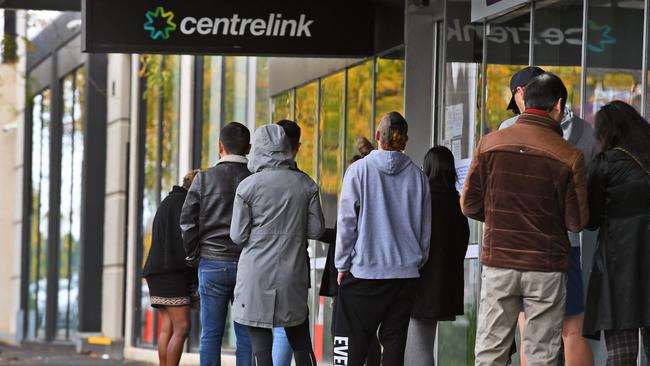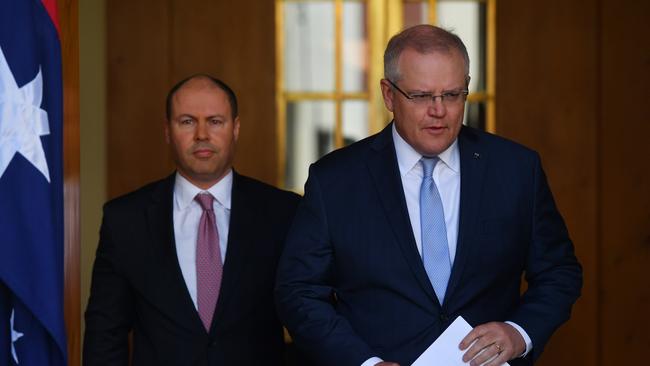ABS shows 600,000 people lost jobs, pushing unemployment rate to 6.2%
Australia has just experienced the largest jump in the number of people out of work on record – but the true picture is even more devastating.
At Work
Don't miss out on the headlines from At Work. Followed categories will be added to My News.
More than half a million Australians lost their job in just one month according to the latest official figures.
Seasonally adjusted employment fell by 594,300 people between March and April, according to the Australian Bureau of Statistics.
That equates to around 19,810 jobs lost each day during that period.
Unemployment increased by 104,500 people to 823,300, and the unemployment rate increased by 1 percentage point from 5.2 per cent to 6.2 per cent.
RELATED: New tax rules you need to know now
RELATED: ‘Biggest shock’: Aussie shares plunge
“The large drop in employment did not translate into a similar sized rise in the number of unemployed people because around 489,800 people left the labour force”, stated Bjorn Jarvis, head of labour statistics at the ABS.
However, the true situation is actually far worse.
While the unemployment rate lifted to 6.2 per cent – better than was widely expected – it doesn’t include those receiving the JobKeeper payment, even if they have been stood down and are now working zero hours per week.
Speaking to ABC News this morning, the Grattan Institute’s Danielle Wood said while experts were expecting the unemployment rate to be higher than 6.2 per cent, the JobKeeper subsidy was “significantly” masking the true extent of the economic damage caused by the coronavirus crisis.

And she stressed the figure was still alarming even though it was slightly lower than expected.
“I mean certainly in terms of the number of people becoming unemployed, (it) is extremely high by historical standards and the rate we are seeing unemployment shoot up again is like nothing we have ever seen,” she said.
“Really, what is going on here as well is we have seen a fall in the participation rate at the same time as a lot of people just decided it wasn’t worth looking for work in the individual environment.
“So in terms of that headline unemployment figure, certainly a bit lower than what we are expecting, but it does really bring home just how significant and how fast this shock has been.”
Ms Wood said it was believed around five million Australians were now on the JobKeeper payment.
“Some of those will be working, but a lot of them will be stood down. So they are not participating in the labour force,” she explained.
“That is why we are seeing that big fall in hours worked, but they are not showing up in those official statistics. It shows that program has been a success.
“But, at the same time, not great for the economy that we do have very significant numbers of people not participating in the labour force at this point in time.”
‘EVEN DEEPER IMPACT’
Prime Minister Scott Morrison said while the numbers were grim and “we have never seen anything like this before”, the nation would “bounce back”.
“We will see those better days and we will come through this together,” he said.

He said the JobSeeker and JobKeeper payments were “holding the nation up” during the crisis – but insisted we “don’t want an Australian economy propped up by subsidies”, which he said were “temporary”.
Mr Morrison also touched on whether the exclusion of JobKeeper from the figured disguised the true story.
“When you get underneath the numbers I think what you’ll see is the estimates that Treasury put together earlier are reflected in these numbers,” he said.
“While the headline rate is just over six (per cent), when you have almost 600,000 people exit employment, that is a devastating set of numbers.
“And when you look at hours worked and all of those issues as well what you do see is an even deeper impact.”
Meanwhile, Treasurer Josh Frydenberg said it was a “tough day” and that the figures were “heartbreaking” – but that Australia had “confronted this global pandemic, this economic shock … from a position of economic strength.”
ABS FIGURES
According to the ABS, large changes were seen across all labour market indicators last month, and the larger than usual number of employed and unemployed people leaving the labour force “resulted in an unprecedented fall in the participation rate by 2.4 percentage points to 63.5 per cent”.
“This means there was a high number of people without a job who didn’t or couldn’t actively look for work or weren’t available for work,” Mr Jarvis said.
Meanwhile, total hours worked fell by around 9.2 per cent between March and April.
It means that in total, around 2.7 million Aussies, or one in five workers who had jobs in March, either left employment or had their hours cut in one month – a far greater figure than previous years.
MORE PAIN TO COME
While today’s figures are worrying, experts believe it’s inevitable things will get worse.
According to Australian property analyst Martin North, Australian unemployment could “quadruple” in the months to come, with Goldman Sachs “unofficially” estimating it could hit 19.8 per cent.
And EY Chief Economist Jo Masters said the numbers confirmed “just how dire conditions are in the jobs market” – and that “it’s likely to get worse before it gets better, despite easing of restrictions”.
“While the lower participation rate cushioned the rise in the unemployment rate, which jumped to 6.2 per cent, well below expectations of 8.3 per cent, this figure is not good news given it is driven by people leaving the workforce,” she said.
“Indeed, this data suggests getting people back to jobs will be even more challenging as they will first need to be enticed back in to the workforce, and then find a job.”
‘DEVASTATING’ IMPACT
Speaking shortly after the release of the figures, Labor leader Anthony Albanese said it was a “devastating” result.
“That is a devastating figure. They are all people with families, with a need to put food on the table for their family and their kids. They are people who are our friends, our relatives, our neighbours, people in our community. They are people also who won’t be receiving the sort of
income that you get in work, which then helps to stimulate the economy,” he said.
“That is the problem here. There will be accumulative event. Not the least of which because when we look at the JobKeeper program the government is still leaving people behind, particularly the most vulnerable.
In two graphs from @ABSStats pic.twitter.com/mJvtgNdFb0
— Sabra Lane (@SabraLane) May 14, 2020
“Our casual employees, people in whole sectors like the arts and entertainment sector aren’t getting the support that they need. The government needs to respond to this. We thought this week, frankly, Budget Day in the formal calendar, that we would see a response from Josh Frydenberg. What we got was a speech out of Seinfeld. A speech about nothing.”
Originally published as ABS shows 600,000 people lost jobs, pushing unemployment rate to 6.2%



